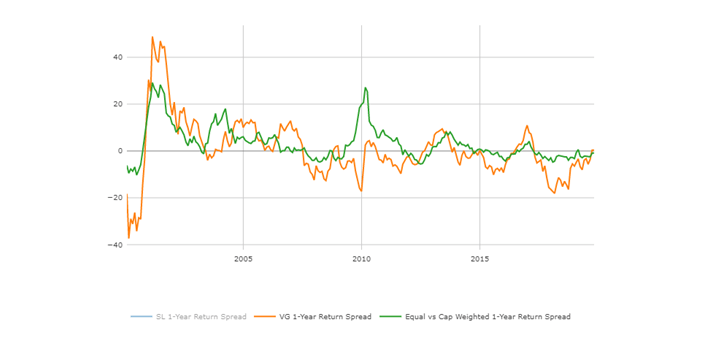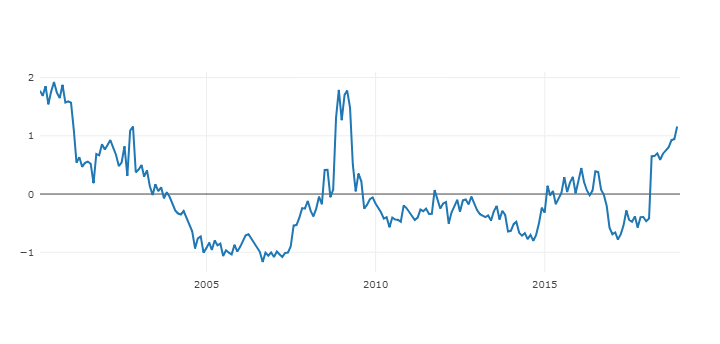US Economics
2017 has been a good year for the U.S. economy, despite some unexpected obstacles to overcome, such as 3 major hurricanes. It appears to us that GDP is on track to grow by 2.3% this year, which would exceed the 1.9% gain produced in 2016. Meanwhile, our 2018 macro model forecasts strength in key cyclical sectors like Industrials, Real Estate and Financials. Higher infrastructure spending and modest benefits from tax reform could provide additional support for that view. We expect GDP to grind higher in 2018 and plateau after that. After a possible 3% growth next year, we may see GDP rise at a more modest pace, perhaps in the 2.0%-2.5% range during the next 3 to 5 years. Obviously, a lot of things could go wrong: global slowdown, war, miscalculations by a Federal Reserve under new management, or a series of fiscal missteps. In a sense, the slow growth rate of this expansion, with its lack of excesses might aid its longevity. The current expansion past its 100th month in November and is now 20 months away from becoming the longest in US history. We see no obvious reason why the expansion needs to end any time soon. Inflation and wages are still in check, and the employment participation rate has room and the capacity for improvement.
Global Economy
Since the last great recession in the US and the following global financial crisis, this expansion was slowed in two major instances: by the Euro area sovereign crisis in 2011-12 and the Emerging markets credit tightening in 2014-16. Post-crisis stress has also negatively impacted business spending and households’ response to improving labor markets. Looks like a combination of time, balance sheet healing, and extraordinary monetary policy accommodation is promoting a more traditional dynamic. Recent economic growth is supported by accommodative financial conditions and rising sentiment. In addition to the pickup in global demand, supply side performance has improved with better productivity and higher labor force growth. Per JP Morgan, the Euro area unemployment rate is expected to slide to 8% and developed markets’ (DM) unemployment rates should drop to their lowest levels since 1980. They expect tight DM labor markets and a recovery in global goods pricing power to lift DM wage inflation and push DM core inflation up 0.4%-pts next year. With growth strong, the combination of negative real policy rates with tight labor markets and rising core inflation will pressure central banks to normalize the interest rates. The pace of rate hikes outside the US is slow with the average policy rate expected to rise 4 basis points through the end of next year. However, many central banks are expected to tighten. The central banks of Canada and the UK have already moved towards normalization, and some emerging markets are expected to raise rates next year. However, most likely the European Central Bank and Bank of Japan will maintain negative rates, while Asian heavyweights China and India will be on hold.
Equities in 2018
We believe the bull market can continue in 2018. Reasons for a positive outlook include: a combination of above-trend US and global economic growth, low but gradually rising interest rates, and profit growth perhaps aided by corporate tax reform. An extended profit cycle could result, which should support rising US equity market prices into 2020, in our opinion.
Sectors: We prefer cyclical sectors for the most part with overweight ratings in Industrials, Financials and Real Estate. This is typical during a mid-cycle expansion phase of the business cycle. Industrials should benefit from solid capital expenditures, potential tax reform, and strong global economic growth. Financials would likely benefit from higher interest rates and deregulation.
Style: Although Growth has been dominating this year we expect Value sectors like Financials to pick up some slack. As such, we have a neutral posturing between Growth and Value stocks. We favor Growth at Reasonable Price strategies, and prefer select companies with healthy revenue growth rates and reasonable price-to-earnings multiples.
Corporate Earnings
Value Line reports that the latest earnings reporting season (covering the third quarter of 2017) was a solid. Roughly three-quarters of the companies in the S&P 500 reported positive earnings surprises. Nearly two thirds of those enterprises also beat expectations on the revenue side. For the latest period, earnings growth was in the high single-digit range, led by gains in energy, technology, and materials stocks. The potential for reduced corporate tax rates could boost earnings further in 2018. Thereafter, if GDP growth moderates, as expected, so should earnings. As before, we expect corporate America to continue to surprise on the upside, particularly in select sectors and industries best positioned to benefit from the current environment.
The information and opinions included in this document are for background purposes only, are not intended to be full or complete, and should not be viewed as an indication of future results. The information sources used in this letter are: Jeremy Siegel, PhD (Jeremysiegel.com), Goldman Sachs, JP Morgan, Empirical Research Partners, Value Line, Ned Davis Research, Citi research and Nuveen.




























































































